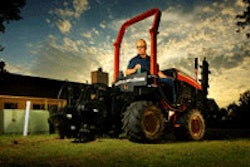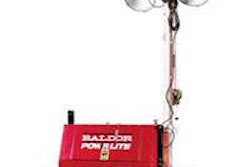 What do you do when 6,000 starlings precipitously invade your power plant? Run for cover!
What do you do when 6,000 starlings precipitously invade your power plant? Run for cover!
“Last fall,” relates Dave Sheetz, mechanic at PacifiCorp’s Dave Johnston Power Plant in Wyoming, “thousands of starlings began roosting all over our power generating units. Their droppings covered the units and dripped all the way down from top to bottom.” To make matters worse, Sheetz adds, the starlings were fond of nearby Russian olive trees, so hundreds of coated olive pits littered the place as well.
Sheetz, who has been with investor-owned electric utility PacifiCorp for 25 years, considered this a serious issue. Enter Richard Bates, a 30-year veteran of PacifiCorp and longtime Supervisor of Operations. “The starlings blackened the sky when they came in flocks of a thousand or more,” Bates confirms. “They’d roost on our electrostatic precipitator and on four steam generators ranging in size from 150 feet to 210 feet tall.”
“We tried hazing methods using noise as a deterrent,” Sheetz says. “The birds would leave temporarily, but they always returned.”
What To Do?
Bates consulted the company’s environmental engineer and began directing research. “I was concerned about the health issues related to the bird droppings,” he notes. “Fungus grows in moist conditions, and airborne particles can cause infection.” Bates knew that the situation would not be acceptable to PacifiCorp’s management at any level.
PacifiCorp is among the West’s largest and lowest-cost producers of electricity. With headquarters in Portland, Oregon, PacifiCorp serves 1.6 million customers in six western states; operating as Pacific Power in California, Oregon, Washington and Wyoming, and as Utah Power in Utah and Idaho. Like any conscientious company, PacifiCorp needs to keep its premises in good working order and its atmosphere healthy for workers and visitors.
Research led Bates to Chicago-based Bird-X, Inc., the manufacturer of an array of bird deterrence products and systems.
“I spoke with a Bird-X consultant, who recommended the BroadBand PRO unit,” says Bates. The unit was sensibly priced, so he could purchase four of them from his Small Tools budget, he recalls.
The BroadBand PRO uses the latest sonic technology to repel pest birds. It is the first device to combine varying species and volumes of high-intensity bird sounds in a multi-tasking mode. That is, the BroadBand PRO features distress cries to indicate danger to starlings, pigeons, gulls and other species while also reproducing the cries of predators like falcons and hawks to add the dimension of extreme threat to the broadcast. The BroadBand’s “repertoire” also includes general bird harassment vocalizations and ultrasonic waves.
Outfitted with four portable speakers, a single unit covers up to 10,000 square feet. The unit is programmable to generate random timing, volume and frequency aimed at annoying birds.
Bird-X indicates that this powerful sound attack forces birds to depart for good, yet doesn’t harm the birds or the environment. The latter is especially important, says Jeff Hymas, Communications Specialist for PacifiCorp, because “PacifiCorp’s corporate mission includes being a responsible environmental steward and wildlife preservationist.”
“I installed two of the units directly on the structural steel on top of power units #1 and #2,” Sheetz explains.
Power unit #4 was taller than the others, so Sheetz placed the BroadBand PRO about three-quarters of the way up the structure, and the fourth unit under the floor of the elevated precipitator. The 60’ X 150’ structure is raised about 20 feet off the ground. “Starlings were nesting underneath the precipitator,” Bates describes.
The BroadBand PRO kit from Bird-X also includes a Terror Eyes globe, a Prowler Owl aerofoil-wing predator and Irri-Tape holographic ribbon as visual supplements to reinforce the audible scare tactics. But Sheetz decided not to use them, due to wind conditions in Wyoming.
Power Up.
Sheetz turned on the unit on the #1 power generating unit. “The whole flock of birds flew away. I assumed they might come back,” he says. And some did. So Sheetz adjusted the settings for frequency and volume, and he re-positioned the speakers to encompass a larger area.
Bates explains how the birds were also roosting in the power unit’s scrubber section, where exhaust gases and emission controls are housed – perhaps providing a warm and cozy spot for nesting. By directing the speakers toward the scrubber, Sheetz successfully bounced the birds back outside. Bates is noticeably pleased.
Besides the annoyance factor, he continues, “we’ve significantly reduced the health hazards for our employees and contract workers.”
Now the birds are no bother. Sheetz changes the programmable settings about once a month, but isn’t sure he needs to. “Birds don’t seem to adapt to the sound.”
Accrued Benefits.
During the initial barrage of birds, the crew was washing off the excessive bird droppings. Days later, the buildup would require another washdown. Bates is happy to have eliminated the frequent re-washings, saving labor costs and time and employee exposure to unsanitary droppings.
Also, he notes, the acidic content of bird droppings could eventually eat through the paint on the power generating units, allowing rust to develop. Bird control is, therefore, preventive maintenance. “It’s a way of maintaining structural integrity,” Bates says.
In summary, Bates says that the units certainly resolved “enough of the problem enough of the time.” He continues: “The birds have relocated away from the powerhouse and gone back into their natural environment. They’re not seeking shelter in our plant areas.”
But Sheetz reminds Bates: “We need at least two more BroadBand units to protect the transformers and switchgear in our substation,” he says. The substation is a natural attraction to birds since it includes wires, beams and transformers – all desirable perching spots for fly-ins.











